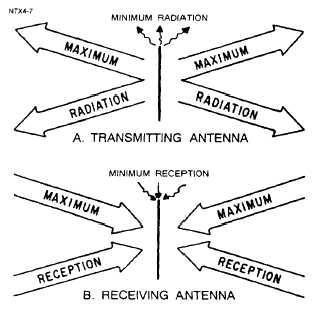Figure 2-1.—Reciprocity of antennas.
elements can be considered
fed from a common source.
GAIN
as a group of antennas
As we mentioned earlier, some antennas are highly
directional. That is, they propagate more energy in
certain directions than in others. The ratio between
the amount of energy propagated in these directions
and the energy that would be propagated if the antenna
were not directional is known as antenna GAIN. The
gain of an antenna is constant. whether the antenna
is used for transmitting or receiving.
POLARIZATION
Energy from an antenna is radiated in the form
of an expanding sphere. A small section of this sphere
is called a wavefront. positioned perpendicular to the
direction of the radiation field (fig. 2-2). Within this
wavefront. all energy is in phase. Usually, all points
on the wavefront are an equal distance from the
antenna. The farther from the antenna the wave is,
the less curved it appears. At a considerable distance,
the wavefront can be considered as a plane surface
at right angles to the direction of propagation.
Figure 2-2.—Horizontal and vertical polarization.
The radiation field is made up of magnetic and
electric lines of force that are always at right angles
to each other. Most electromagnetic fields in space
are said to be linearly polarized. The direction of
polarization is the direction of the electric vector. That
is, if the electric lines of force (E lines) are horizontal,
the wave is said to be horizontally polarized (fig. 2-2),
and if the E lines are vertical, the wave is said to be
vertically polarized. Since the electric field is parallel
to the axis of the dipole, the antenna is in the plane
of polarization.
A horizontally placed antenna produces a horizon-
tally polarized wave, and a vertically placed antenna
produces a vertically polarized wave.
In general, the polarization of a wave does not
change over short distances. Therefore, transmitting
and receiving antennas are oriented alike, especially
if they are separated by short distances.
Over long distances, polarization changes. The
change is usually small at low frequencies, but quite
drastic at high frequencies. (For radar transmissions,
a received signal is actually a wave reflected from
an object. Since signal polarization varies with the
type of object, no set position of the receiving antenna
is correct for all returning signals). Where separate
antennas are used for transmitting and receiving, the
receiving antenna is generally polarized in the same
direction as the transmitting antenna.
2-2



